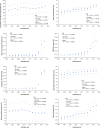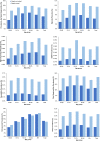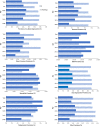Prevalence of spine degeneration diagnosis by type, age, gender, and obesity using Medicare data
- PMID: 33686128
- PMCID: PMC7940625
- DOI: 10.1038/s41598-021-84724-6
Prevalence of spine degeneration diagnosis by type, age, gender, and obesity using Medicare data
Abstract
Identifying the prevalence of degenerative spinal pathologies and relevant demographic risk factors is important for understanding spine injury risk, prevention, treatment, and outcome, and for distinguishing acute injuries from degenerative pathologies. Prevalence data in the literature are often based on small-scale studies focused on a single type of pathology. This study evaluates the prevalence of diagnosis of selected degenerative spinal pathology diagnoses using Medicare insurance claim data in the context of published smaller-scale studies. In addition, the data are used to evaluate whether the prevalence is affected by age, sex, diagnosed obesity, and the use of medical imaging. The Medicare Claims 5% Limited Data Set was queried to identify diagnoses of degenerative spinal pathologies. Unique patient diagnoses per year were further evaluated as a function of age, gender, and obesity diagnosis. Participants were also stratified by coding for radiological imaging accompanying each diagnosis. The overall prevalence of diagnosed spinal degenerative disease was 27.3% and increased with age. The prevalence of diagnosed disc disease was 2.7 times greater in those with radiology. The results demonstrate that degenerative findings in the spine are common, and, since asymptomatic individuals may not receive a diagnosis of degenerative conditions, this analysis likely underestimates the general prevalence of these conditions.
Conflict of interest statement
The authors declare no competing interests.
Figures




References
-
- Cheng JS, Forbes J, Wong C, Perry E. The epidemiology of adult spinal deformity and the aging population. In: Wang M, Lu Y, Anderson D, Mummaneni P, editors. Minimally Invasive Spinal Deformity Surgery. Berlin: Springer; 2014.
-
- Ogden, C. L., Carroll, M. D., Fryar, C. D. & Flegal, K. M. Prevalence of obesity among adults and youth: United States, 2011–2014. U.S. Department of Health and Human Services, NCHS Data Brief No. 219. https://www.cdc.gov/nchs/products/databriefs/db219.htm (2015). - PubMed
MeSH terms
LinkOut - more resources
Full Text Sources
Other Literature Sources
Medical

